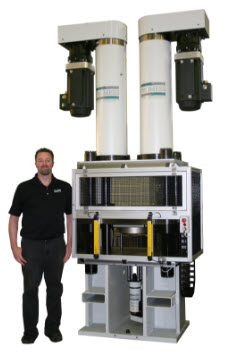By: Stephanie Price, Applications Engineer, Promess, Inc
Industrial automation can seem like magic, especially when used in assembly operations. Learn what you need to about the basics to help in your next automation project with our servo press guide.

Servo mechanisms are at the heart of 21st century automation. The basic elements are a servomotor; a device to convert rotary motion into linear motion; a suite of sensors to provide the required feedback; a controller to convert feedback data into command signals; and enabling software. This is the “magic” of high-speed, precision assembly operations. With 21st century advances in their base components, servo presses are a game-changing technology.
They are not just fast and precise—they have gone big as well. In the metal forming and stamping industries, servo presses are available with capacities up to 5,000 tons (4,536 metric tons) and larger units are under development. These presses are changing the way users approach process design by giving engineers precise control of force, speed and position in real-time during an entire stroke of a process.
Thirty years ago, industry pioneers combined a precision ballscrew with a servomotor, rotary encoder and load cell to produce the first Electro-Mechanical Assembly Press (EMAP) designed specifically for assembly operations.
Successful Early Adopters
Early adopters found the ability to measure process parameters during assembly allowed them to literally “clone” products by comparing the force/position “signature” of each operation to that of a known good cycle and adjusting press parameters in real-time to duplicate it. That basic concept has been used in hundreds of different assembly applications, from simple riveting to installation of high-value electronics. Here are a few examples.
Universal Joint Assembly: A Cardan-type universal joint has a center cross or “spider” that is attached to a pair of U-shaped arms by pressing a bearing cup through a hole in the arm to capture a machined journal on the “spider.” Once assembled, the bearing cups are staked to the arm to keep them in place.
The challenge is to keep the spider centered in the arm while the bearing cups are pressed in and staked. This is accomplished with a pair of EMAPs that are synchronized to apply the same force to each bearing cup while it’s being inserted. Once the cups are in place, the spider is precisely centered and the EMAPs simultaneously perform the staking operation. Since equal force is applied to opposing legs of the spider, it remains centered and the result is a good assembly each time.
This application works because the EMAPs are monitored during the operation and adjusted for force and position in real-time by the control. Data from the whole process can be captured and stored for quality assurance, providing 100-percent traceability for each assembly. That data is also useful for identifying and correcting anomalies in the parts being assembled, which improves the quality of the entire supply chain as well as the assembly process.
Medical Catheter Assembly: The critical operation is a crimping process that attaches a small-diameter metal tube to a larger tube that’s attached to the flexible portion of the catheter. If the crimp isn’t perfect, it will either come apart when it’s pulled on or it will close off the tube completely, rendering the catheter useless. Consistently crimping a tiny metal tube to one that’s only slightly larger proved to be a monumental challenge.
The key to maintaining consistent quality in the catheter crimping operation was monitoring both the amount of force being applied and the exact position of the crimping tool simultaneously. Once both parameters of a known good operation were captured, the force/position “signature” was used as a benchmark to measure subsequent operations.
An EMAP-based crimping station, complete with external position transducers, is used to perform the crimping operation on the catheters. The EMAP provides repeatable crimping force and the transducers monitor the tooling to make sure the crimp is neither too shallow nor too deep. The result is a 100-percent effort test certification for every catheter produced and the virtual elimination of crimp failures in the field.
Riveted Ball-Joint Assembly: Automotive ball-joint assemblies are safety-critical components that typically are attached to upper and lower control arms with rivets. There are three possible failure modes: 1) a rivet may be too long or too short, 2) a rivet may be too hard or too soft, and 3) a rivet may be missing entirely. Because the assembly is safety critical, a 100-percent post riveting inspection has traditionally been performed.
Using an EMAP-based system instead of a traditional hydraulic press eliminates the 100-percent inspection requirement by monitoring the process while it is being performed and comparing the “signature” to a known good operation. Three individual load cells are mounted into the tooling to independently measure the force applied to each rivet, while a single-position transducer measures the ram’s travel distance. Rivets that are too hard or soft, or too short or long, will produce a distinct change in the signature, as will out-of-tolerance details such as hole diameters.
The system provides: long, short, hard, soft, and/or missing rivet detection; 100-percent certification of every assembly; built-in data acquisition; and a record of force and position data for every part produced—all in real time during the process cycle. The results are consistent, accurate, and traceable, which means post-process inspections on every part are no longer necessary to assure quality.
Moving Beyond The Basics
It didn’t take long for the early adopters to realize that the detailed process data generated by an EMAP-based system had uses far beyond simply comparing “signatures” and “cloning” assemblies. EMAP suppliers were also busy enhancing both hardware and software capabilities to support more advanced applications.
One of the first applications to take advantage of these advances was the assembly of automotive control arms, a product that requires geometric precision to achieve proper function, yet is made of components that cannot be produced economically with very close tolerances. The control arm is made up of heavy-duty stamping or casting with rubber-encased bushings pressed in place–clearly not a candidate for extreme dimensional precision.
What automotive engineers typically do is define the geometry required in the assembly and leave the “how-to-achieve-it” part up to the supplier. Suppliers call this a “phantom” dimension, and it’s quite common in a variety of industries.
The Conventional Approach
The conventional approach to meeting the specification for a “phantom” dimension is to build precise tools and fixtures and then continuously adjust them to deal with constant, unpredictable variations in the parts. Other suppliers choose to “press and hope,” then “measure and sort” and accept scrap and re-work costs. To meet this challenge instead with an EMAP-based system requires advanced software to handle additional sensors outside of the load cells integrated in the press. The assembly is done with two EMAPs and two digital probes. These probes are needed because the resilient bushings flex during installation, making it difficult to know their precise location. The probes also compensate for machine and load cell deflection.
To assemble the control arm, the bushings are pressed to an initial position, the force is removed, and the location is measured by the digital probes. One bushing is pressed to a dimension that is relative to the ball joint. The probe measures the position and feeds the information back to the controller, which tells the press how much further to press. This sequence repeats until the bushing is in place. The other bushing uses the same installation sequence but is pressed to a dimension relative to the first bushing. This is the “phantom” dimension and the system can efficiently and repeatably achieve it regardless of variations in the control arm and/or bushings.
The system just described significantly improves the functional quality of the control arm it assembles with no change in the dimensional specifications of the component parts. In fact, it’s quite possible that the tolerances on those component parts could be loosened to reduce manufacturing costs with no impact on the finished product’s functional quality. Function is the consumer’s measure of quality, and with the kind of intelligent assembly pioneered by the control arm system it can be the manufacturer’s as well.
A Mature Technology
As intelligent assembly applications have proliferated, so have the hardware and software systems required to enable them. Today, EMAPs are available with force outputs ranging from 0.2 kN to 1,000 kN and can be equipped with a broad range of integral and external sensors. They are available as individual components to system builders, H-frame presses and flexible stand-alone workstations for end users.
Innovative engineers have made EMAPs light enough to be used as robot end effectors and even human hand-held models are available. Both of these products are intended for applications in which the press is brought to the part, which means that the reaction force of the pressing operation cannot be transmitted to the robot or human operator.
Linear EMAP/Rotary Actuator Combo
Another trend is the combination of a linear EMAP with a rotary actuator to facilitate functional testing during assembly. For example, an automotive hood latch is assembled with a rivet using an EMAP. While the rivet is being peened, the latch is actuated and the required force continuously measured until it reaches a specified level, at which point the process is stopped. The process produces latches with uniform actuating force regardless of variations in rivets or stampings. Similar systems are used to assemble automotive seat latches, pliers, and even to check gear backlash under load in automotive differentials.
All of these applications depend on sophisticated controllers and software to handle and integrate multiple data inputs in real time and generate the necessary servo commands. Controls are now available with the ability to synchronize multiple EMAPs driving the corners of a platen press so that each one generates the force necessary to keep the platens parallel, even though the load is not uniform.
Control software has evolved along with hardware, and today’s systems are much easier to program than their predecessors of even a few years ago. Suppliers have invested significant time and talent in systems that simplify the process to the point where professional control engineers often are not required.
As EMAP technology has matured, the concepts of intelligent assembly and assembly to a functional specification rather than a dimensional one have become increasingly practical across a broad range of industries. Maturity, however, does not imply stagnation. The technology continues to grow by enabling truly innovative solutions to challenges that have plagued manufacturers for decades, and in some cases centuries.
Check out this article to learn more about intelligent press systems
